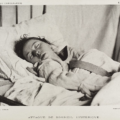Recently, I was contacted by a patient who raises a good point that I have been pondering awhile – doctors becoming angry at patients. In this case, the patient was asking questions about the advisability of working with the utero-sacral ligaments and pelvic floor support when her he blew up at her. This is not the first time we have had reports of a specialist unloading on a patient. It’s hard to say why these things happen, every case is different, but in my 52 years as a nurse I have some thoughts.
In the past patients accepted blindly what doctors said and offered. For many this worked out OK. They did, after all, know more than we on any given subject. And for doctors this was the most efficient way.
In endometriosis, with less than 100 doctors doing effective surgery, the ‘doctor as expert’ model has not worked out so well. So part of the endometriosis awareness process has been to educate women with as much information as we know and understand about endometriosis. This leads to informed patients who want to fully understand everything that is being recommended or discussed; patients who now understand why so many of their treatments in the past have failed.
To the doctor who truly is an expert, he or she is comfortable with their knowledge base. For some physicians, however, particularly those who are not well versed in endometriosis, questions can be taken as affronts even when posed in the nicest way. The reaction can be surprising to the patients because they are trying to become more educated, to understand fully so as to avoid the revolving operating room door of one ineffective surgery after another.
What to Do When the Doctor Patient Relationship Sours
While most of the experts do not have issues with interactions, occasionally they do go south. We always have had to walk the fine line between ego and skill with doctors. Not all doctors are like this, but ask any nurse who has been in the field for a number of years, and you will find that some are. Here nurses can be allies. Over the years the nurse doctor relationship has improved for the most part and physicians have come to see nurses as assets, as opposed to subservient workers. I suspect we will see the same evolution between educated patients and doctors as time goes on. Even now, I run into doctors who appreciate patients coming to the office with a better understanding of their disorders, as it saves time and makes treatment and patient education needs easier. So if you are having difficulty with a doctor, if you have questions that are not being addressed, ask the nurse as she often has the doctors ear and can be helpful. Not all doctors offices employ nurses though so ask to be sure.
Dr. Google Evoking Tensions within the Doctor Patient Relationship
Sometimes the information on message boards and other internet groups is incorrect. This can be frustrating for the physician and confusing for the patient, particularly when the situation is not handled appropriately. In these cases, it is a good idea to check with the nurse, perhaps review the information and even get a second opinion for clarity. As someone who works online to educate patients, I understand sometimes our information is incorrect. In our case, we have been fortunate to have some physicians, who are willing to sort out our misinformation and correct our teachings. To the extent we may have a role in the misunderstandings between patients and doctors, then I apologize.
What I won’t apologize for, is helping women and their families understand why things have not worked in the past and what to avoid for the future leads to better care. That means for endometriosis care and education we are looking for doctors who are committed to excision of disease, who can help patients in one or two surgeries, who do not feel the need to use GnRH agonists or other medical therapy (which has never been shown to TREAT endometriosis but may quiet symptoms temporarily). True experts in excision have had long-lasting relief for their patients in one or two surgeries, and will only use drug therapy post op to stop periods where the uterus is quite painful and the patient wants to keep it. Then, with periods suppressed a patient may well be able to keep her uterus and have less pain until conception or until she reaches menopause.
The Second Opinion
In reality, a good doctor will welcome your questions. If you are running into resistance then it might be time to seek the opinion of another specialist. Sometimes it is a simple matter of personality differences and no matter what you do, things will not improve. It is OK to move on if you are not comfortable.
This article was published originally on Hormones Matter in March 2014
We Need Your Help
Hormones Matter needs funding now. Our research funding was cut recently and because of our commitment to independent health research and journalism unbiased by commercial interests we allow minimal advertising on the site. That means all funding must come from you, our readers. Don’t let Hormones Matter die.










